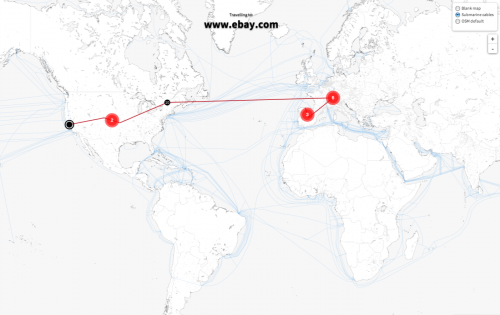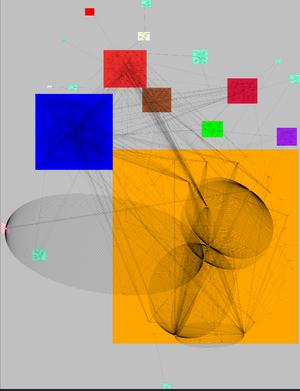User:Roelroscama/gradreserach: Difference between revisions
Roelroscama (talk | contribs) |
Roelroscama (talk | contribs) No edit summary |
||
| Line 3: | Line 3: | ||
The Providers? | The Providers? | ||
== Introduction == | == Introduction and relation to previous practice == | ||
During my first year at the PZI I became interested in the infrastructure of the internet. That year [[User:Roelroscama/trim1/protoyping |I began experimenting with Traceroute]] which lead me to producing maps and diagrams that explored how I connected to the internet. A particular interest came from GeoIP libraries that I used to connect the servers and websites I visited to countries and physical locations on the planet. With this in mind I applied to the summer sessions residency and I made [[User:Roelroscama/gradreserach#Border_Check | Border Check]] to further explore my interests this topic. | |||
My interests in this topic stem mostly from the fact that the internet, and notably the world wide web have been described and regarded from the beginning as tools for empowerment and personal liberation. At the same time the study of the history, topology and actors within the of the network of networks reveals a more nuanced or perhaps opposing image. | |||
Through working on Border Check I realised the interesting role of telecommunications companies and internet service providers in shaping the topology of the network. As a consequence I focussed on researching the history of telecommunications and especially electro magnetic telegraphy. | |||
[[User:Roelroscama/gradproject#Practical_steps | After having explored multiple possibilities]] | [[User:Roelroscama/gradproject#Practical_steps | After having explored multiple possibilities]] I feel it's best to continue to develop Border Check as a graduation project. Although I managed to make a good start during the summer the project is far from finished. At the same time the software remains quite instrumental for me to discover and map out the infrastructure. | ||
== Key Words == | == Key Words == | ||
Revision as of 01:08, 2 December 2013
Tentative Title
The Providers?
Introduction and relation to previous practice
During my first year at the PZI I became interested in the infrastructure of the internet. That year I began experimenting with Traceroute which lead me to producing maps and diagrams that explored how I connected to the internet. A particular interest came from GeoIP libraries that I used to connect the servers and websites I visited to countries and physical locations on the planet. With this in mind I applied to the summer sessions residency and I made Border Check to further explore my interests this topic.
My interests in this topic stem mostly from the fact that the internet, and notably the world wide web have been described and regarded from the beginning as tools for empowerment and personal liberation. At the same time the study of the history, topology and actors within the of the network of networks reveals a more nuanced or perhaps opposing image.
Through working on Border Check I realised the interesting role of telecommunications companies and internet service providers in shaping the topology of the network. As a consequence I focussed on researching the history of telecommunications and especially electro magnetic telegraphy.
After having explored multiple possibilities I feel it's best to continue to develop Border Check as a graduation project. Although I managed to make a good start during the summer the project is far from finished. At the same time the software remains quite instrumental for me to discover and map out the infrastructure.
Key Words
infrastructure history people in a system symbols/semiotics self-representation networks of control
Relation to a larger context
Some artists and projects I find interesting in this relation: Melle Smets de Snelweg Safari, about vernacular highway culture. Trevor Paglen, on secretive infrastructures. Metahaven's design/image centric approach to infrastructure.
There is this thing called 'stacktivism' which seems to be to the infrastructure discussion what 'The New Aesthetic' was to digitally native aesthetics. It's dealing with questions of determinism in net infrastructure and the geopolitics of it. I'm not too enthousiastic about it but people active within this context could be considered peers.
Practical Steps
Do a visual research into how members of (on-line)communities of network administrators represent themselves.
Ask technical questions on these forums designed to get answers that might reveal a bit about the way they perceive a network in terms of politics (should everyone be given as much rights on the machine? If so why? What are the hirarchies?)
Bibliotecha will be set up within the school and I will experiment to see how it's use is built into the system, eg. do certain systems illicit certain behaviours?
Go to Are You Being Served?
References
Alexander Galloway, Protocol
Evgeny Morozov,To Save Everything Click Here
Tom Standage, Victorian Internet
Wendy Chun, Control and Freedom
Gilles Deleuze, Postscript on the societies of control
Descriptions of previous work
Border Check
Border Check (BC) is a browser extension that maps how your data moves across the internet’s infrastructure while you surf the web. It will show you through which countries and networks you surf to illustrate the physical and political realities of the internet’s infrastructur using free software tools.
Telewar
Telewar is a research project by The Force of Freedom and Dave Young on the topic of drone warfare. The project was initiated in november 2012 during a three week residency at Upominki in Rotterdam. The result of the residency was a self-published booklet containing an heavily illustrated essay. In it we try to make some sense of the drone warfare phenomenon by looking at how the users of military UAVs represent themselves both officially and unofficially. This is done by examining places, images or artifacts where an official and regulated narrative on drones intersects with with a more spontaneous and uncensored one. Examples include public facebook profiles of UAV squadrons, the online second hand market for drone-related insigna and offical documents conerning the topic.
The latest iteration of the project consists of two film loops. One is a taxonomy of UAV uniform patches. In this film a collection of patches is categorized and classified into four distinct topics, animals, flight hours, mythology and the earth as a grid. By making this taxonomy and studying the symbols for their connotation and their history the viewer gets a better insight in how UAV operators view themselves and the world. The second film is a lexicon of drone terminology. By juxtaposing military jargon with images it tries to scrutinize the pentagon euphemisms that are used to talk about UAVs and the Global War on Terror.



